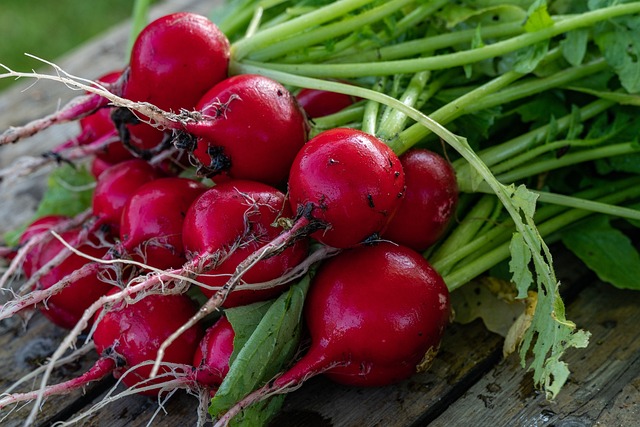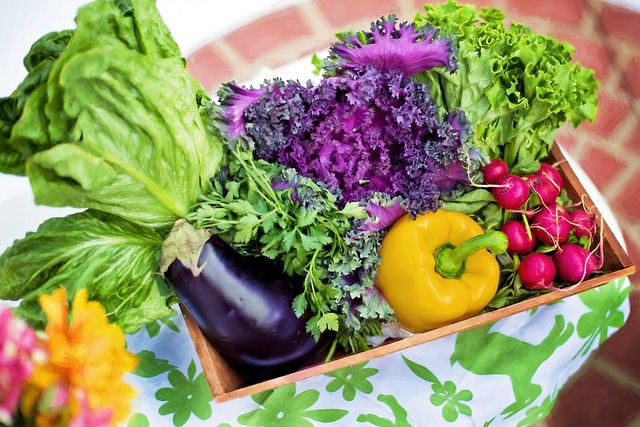Imagine enjoying fresh tomatoes or crispy lettuce straight from your own garden with minimal effort. In this post, we’ll guide you through the simplest and most rewarding options, focusing on the easiest fruits and vegetables to grow for beginners. Growing your own produce is not only satisfying but also surprisingly easy, so let’s look at the best choices to start your garden!
Table of Contents
Tomatoes: Versatile and Abundant
Let’s kick things off with one of the easiest fruits and vegetables to grow for beginners: tomatoes! These juicy, flavorful fruits come in all shapes, sizes, and colors, making them a delightful addition to any garden. From tiny cherry tomatoes bursting with sweetness to hefty beefsteak varieties perfect for slicing, there’s a tomato for every palate.
Why Tomatoes Are the Best Choice for Beginner Gardeners
What makes tomatoes so great for beginners? Well, for starters, they’re incredibly versatile. You can grow them in containers on your patio, in raised beds, or directly in the ground. Plus, they’re not too picky about where they grow, which is why they’re among the easiest fruits and vegetables to grow for beginners, as long as they get plenty of sunlight and regular watering.
Types of Tomatoes: Determinate vs. Indeterminate
Determinate tomatoes are characterized by their compact and bushy growth habit. They reach a specific height and then stop growing, typically around 4 feet tall. This makes them ideal for smaller gardens or container gardening as they require less space. Once a determinate tomato plant sets its fruit, it focuses its energy on ripening those tomatoes rather than producing new flowers. This results in a concentrated harvest period, often producing a large quantity of tomatoes within a relatively short timeframe. Determinate varieties are often preferred for canning and preserving due to their abundant yield.
Indeterminate tomatoes have a vining growth habit and continue to grow throughout the season, producing flowers and fruit continuously until frost. These plants can reach impressive heights, sometimes exceeding 8 feet, so they require sturdy support structures like cages or stakes to prevent them from sprawling. While indeterminate tomatoes may not produce as large a harvest at once as determinate varieties, they offer a continuous supply of ripe tomatoes over an extended period. This makes them perfect for fresh eating and slicing
Tips for Successful Tomato Growing
First off, they love sunlight, so make sure they get at least 6-8 hours of direct sun each day. And when it comes to watering, consistency is key. Keep the soil evenly moist, but not waterlogged, to avoid issues like blossom end rot.
Tomatoes are heavy feeders, so be sure to give them a boost with some fertilizer every few weeks to keep them happy and productive. With a little TLC, you’ll be rewarded with a bountiful harvest of delicious, homegrown tomatoes in no time!
Lettuce: One of the Easiest Vegetables to Grow for Beginners
Now, let’s talk about lettuce – the king of quick and easy greens! Whether you’re craving a crisp salad or a tasty wrap filler, lettuce has got you covered. And the best part? It’s one of the fastest-growing veggies out there, making it perfect for impatient beginners.
So, what makes lettuce such a breeze to grow? Well, for starters, it’s incredibly quick to germinate and mature. You can go from seed to salad bowl in just a matter of weeks, which is pretty impressive if you ask me. Plus, there are tons of different types to choose from, like leaf lettuce, romaine, and butterhead, each with its own unique flavor and texture.
Tips for Growing Lettuce Successfully
When it comes to growing lettuce, the key is to keep things simple. You can plant it directly in the ground, in raised beds, or even in containers if space is limited. Just make sure to space your plants out to give them room to grow and avoid overcrowding.
Lettuce loves cooler temperatures, so try to plant it in early spring or late summer for the best results. And when it comes to watering, keep the soil consistently moist – not too soggy, not too dry.
The great thing about lettuce is that you can harvest it at various stages. If you’re in a hurry, you can pick individual leaves as needed for a continuous harvest. Or, if you’re patient enough to wait, you can let your lettuce plants mature into full heads for a bigger yield.
Radishes: Rapid and Colorful Additions

Now, let’s talk about radishes – the speedy superheroes of the vegetable garden! If you’re looking for a crop that will give you quick gratification and add a pop of color to your garden beds, radishes are the way to go.
What makes radishes so special? Well, for starters, they’re incredibly fast growers. Seriously, we’re talking lightning-fast here – some varieties can go from seed to harvest in as little as three weeks! This makes them perfect for impatient beginners who want to see results fast.
Vibrant Variety
Radishes also come in a rainbow of colors, from classic red to vibrant purple and even pure white. Plus, there are different shapes and sizes to choose from, ranging from round to cylindrical to long and slender.
How to Easily Grow Radishes
When it comes to growing radishes, the process is pretty straightforward. You can sow the seeds directly in the ground, in raised beds, or even in containers if space is limited. Just make sure to plant them in well-draining soil and keep them watered consistently.
Intercropping Benefits
One of the great things about radishes is that they’re excellent for intercropping. This means you can plant them between rows of slower-growing veggies like carrots or lettuce to make the most of your garden space. Plus, they help break up the soil and suppress weeds, making them a win-win for your garden.
Harvesting Rewards
When it comes time to harvest your radishes, you’ll know they’re ready when you see the tops poking out of the soil and feel the bulbs firm to the touch. Just grab a handful, give them a gentle tug, and voila – instant gratification in the form of crunchy, peppery radishes straight from your garden!
Zucchini: Prolific and Nutritious Squash
Let’s talk about zucchini – one of the easiest fruits and vegetables to grow for beginners – the versatile and abundant summer squash that’s a staple in many home gardens. If you’re a beginner looking for a crop that’s easy to grow and yields a bountiful harvest, look no further than zucchini.
Benefits of Growing Zucchini
What makes zucchini such a great choice for beginners? Well, it’s definitely one of the easiest fruits and vegetables to grow for beginners, and it’s a prolific producer too. Seriously, once zucchini plants get going, they can churn out more squash than you know what to do with. So be prepared to share the bounty with friends and neighbors!
Zucchini plants are also relatively low-maintenance. They prefer warm weather and plenty of sunlight, so make sure to plant them in a sunny spot with well-draining soil. And while they do need regular watering, they’re pretty forgiving if you forget to water them once in a while.
One thing to keep in mind with zucchini is that they can get pretty big, so make sure to give them plenty of space to spread out. If you’re short on space, you can also train them to grow vertically on a trellis or fence, which can help save space and keep your garden looking tidy.
How to Harvest Zucchini: Best Practices for Beginner Gardeners
Remember, bigger doesn’t equal better. As zucchinis mature, they turn tough and bland with harder seeds.
For the tastiest zucchinis, timing is crucial. Unlike other veggies, younger is better! Aim for zucchinis between 6 and 8 inches long, although some varieties are delicious even at 4 or 5 inches.
To catch them at their peak, check your plants daily, especially during their growth spurts. This way, you won’t miss the perfect picking window!
Grab some sharp pruners, scissors, or even a knife – anything to make a clean cut. This helps keep your plant healthy and growing strong. Leave an inch or two of stem on your zucchini when you cut it. This little stem helps it stay fresh for longer in the kitchen. Some folks say you can just twist the zucchini off, but that’s a gamble! You might end up ripping the vine or hurting the zucchini itself. Play it safe and use your sharp tools instead.
Finally, zucchini plants can be sneaky! Those big leaves love to hide zucchinis, so be sure to peek under them to make sure you’re not missing any hidden treasures.
Zucchini’s Nutritional Value
Zucchini is not only delicious but also incredibly nutritious. It’s low in calories and packed with vitamins and minerals like vitamin C, potassium, and manganese.
So whether you’re grilling it, sautéing it, or baking it into bread, you can feel good about enjoying this versatile and nutritious summer squash straight from your garden.
Green Beans: Easy and Satisfying Harvests
Green beans are among the easiest fruits and vegetables to grow for beginners and are a fantastic choice for those looking for a rewarding and easy-to-grow crop. These crisp and flavorful legumes are not only delicious but also incredibly versatile in the kitchen. Let’s dive into why green beans are such a great option for beginners.
Ease of Cultivation
Green beans are known for their ease of cultivation. Whether you’re growing bush varieties or pole beans that climb, they’re relatively low-maintenance plants. This makes them perfect for beginners who are just getting started with gardening. Plus, they’re pretty forgiving if you make a few mistakes along the way.
Bountiful Harvests
Another reason why green beans are so beginner-friendly is their bountiful harvests. These plants are prolific producers, meaning you’ll have plenty of beans to enjoy throughout the growing season. And the best part? They’re easy to harvest – just pick the beans when they’re young and tender, about the size of your pinky finger.
Nutritional Benefits
Green beans also have the added benefit of being nutritious. They’re rich in vitamins like A, C, and K, as well as fiber and protein. So not only are you getting a delicious crop from your garden, but you’re also nourishing your body with essential nutrients.
Tips for Successful Growth
For bush beans, spacing the plants properly ensures good air circulation and helps prevent disease. Pole beans, on the other hand, need support like trellises or stakes to climb on.
Green beans also prefer well-draining soil and plenty of sunlight, so choose a sunny spot in your garden to plant them. And don’t forget to water them regularly, especially during hot, dry weather.
With their ease of cultivation, satisfying harvests, and nutritious benefits, green beans are a must-have for any beginner gardener. So go ahead, plant some seeds, and get ready to enjoy the delicious rewards straight from your garden!
Strawberries: Sweet and Succulent Treats

Ah yes, the delightful world of strawberries – another example of the easiest fruits and vegetables to grow for beginners – the sweet and succulent fruits that are sure to bring joy to any garden. If you’re a beginner gardener looking for a fruit that’s easy to grow and incredibly rewarding, strawberries are the perfect choice.
Versatility in Growth
What makes strawberries so special? Well, for starters, they’re incredibly versatile. You can grow them in containers, hanging baskets, raised beds, or directly in the ground, making them suitable for gardens of all sizes. Plus, they’re perennial plants, meaning they’ll come back year after year, giving you a steady supply of delicious berries.
Types of Strawberries
One of the great things about strawberries is that there are different types to choose from, including June-bearing, everbearing, and day-neutral varieties. Each type has its own unique fruiting habits, so you can choose the one that best fits your needs and preferences.
Simple Cultivation
When it comes to growing strawberries, the process is relatively simple. They prefer well-draining soil and plenty of sunlight, so make sure to plant them in a sunny spot in your garden. And while they do need regular watering, they’re pretty drought-tolerant once established.
Caring for Your Crop
One thing to keep in mind with strawberries is that they’re prone to pests like birds and slugs, so you may need to take steps to protect your berries. You can use bird netting to keep birds at bay, and beer traps or copper tape to deter slugs.
Harvesting and Enjoyment
When it comes time to harvest your strawberries, you’ll know they’re ready when they’re fully red and ripe. Just gently twist the berries off the stem, being careful not to damage the plant. And the best part? You can enjoy your homegrown strawberries fresh off the vine or use them to make delicious jams, pies, and desserts.
With their sweet flavor, vibrant color, and easy cultivation, strawberries are a must-have for any beginner gardener. So go ahead, plant some strawberry plants, and get ready to enjoy the sweet rewards straight from your garden!
Cucumbers: Refreshing and Rewarding Vines
Let’s turn our attention to cucumbers – the refreshing and versatile veggies that are a staple in salads, sandwiches, and pickles. If you’re a beginner looking for a satisfying crop that’s easy to grow and incredibly rewarding, cucumbers are an excellent choice.
Why Cucumbers are One of the Easiest Vegetables to Grow
So, what makes cucumbers such a great option for beginners? Well, for starters, they’re relatively low-maintenance plants. As long as they have plenty of sunlight, well-draining soil, and regular watering, they’ll thrive in your garden. Plus, they’re fast-growing, so you’ll start seeing results in no time.
Types of Cucumbers: The Easiest Choices for Your Garden
Among the easiest fruits and vegetables to grow for beginners, cucumbers come in two main types: slicing cucumbers and pickling cucumbers.
- Slicing cucumbers are typically larger with smooth skins, perfect for adding to salads or eating fresh (what you see in your local grocer).
- Pickling cucumbers are smaller with bumpy skins, ideal for making crunchy pickles.
Essential Tips for Growing Cucumbers: Simple Guidelines for Beginners
When it comes to growing cucumbers, there are a few things to keep in mind. First, they’re vining plants, so they’ll need some support to climb. You can use trellises, stakes, or cages to keep them off the ground and save space in your garden.
Cucumbers also prefer warm weather, so make sure to plant them after the threat of frost has passed. And while they do need regular watering, be sure not to overwater them, as this can lead to issues like root rot.
Harvesting Cucumbers: Enjoying Your Easy-to-Grow Crop
When it comes time to harvest your cucumbers, you’ll want to pick them when they’re young and tender – about 6 to 8 inches long for slicing cucumbers and 2 to 4 inches long for pickling cucumbers. Just cut them from the vine using a pair of scissors or a knife, being careful not to damage the plant.
With their refreshing flavor, culinary versatility, and easy cultivation, cucumbers are a fantastic choice for beginner gardeners. So go ahead, plant some cucumber seeds or seedlings, and get ready to enjoy the crisp, refreshing taste of homegrown cucumbers straight from your garden!
Seeds of Success
Starting with these easy-to-grow options offers a gentle introduction to gardening. Each crop, from tomatoes to cucumbers, brings unique charm and benefits. By planting them, you nurture a deeper connection to nature and foster a sustainable lifestyle.
Embrace each milestone in your gardening adventure, learning from experimentation and enjoying the process. Get your hands dirty and relish the bountiful harvests ahead!

